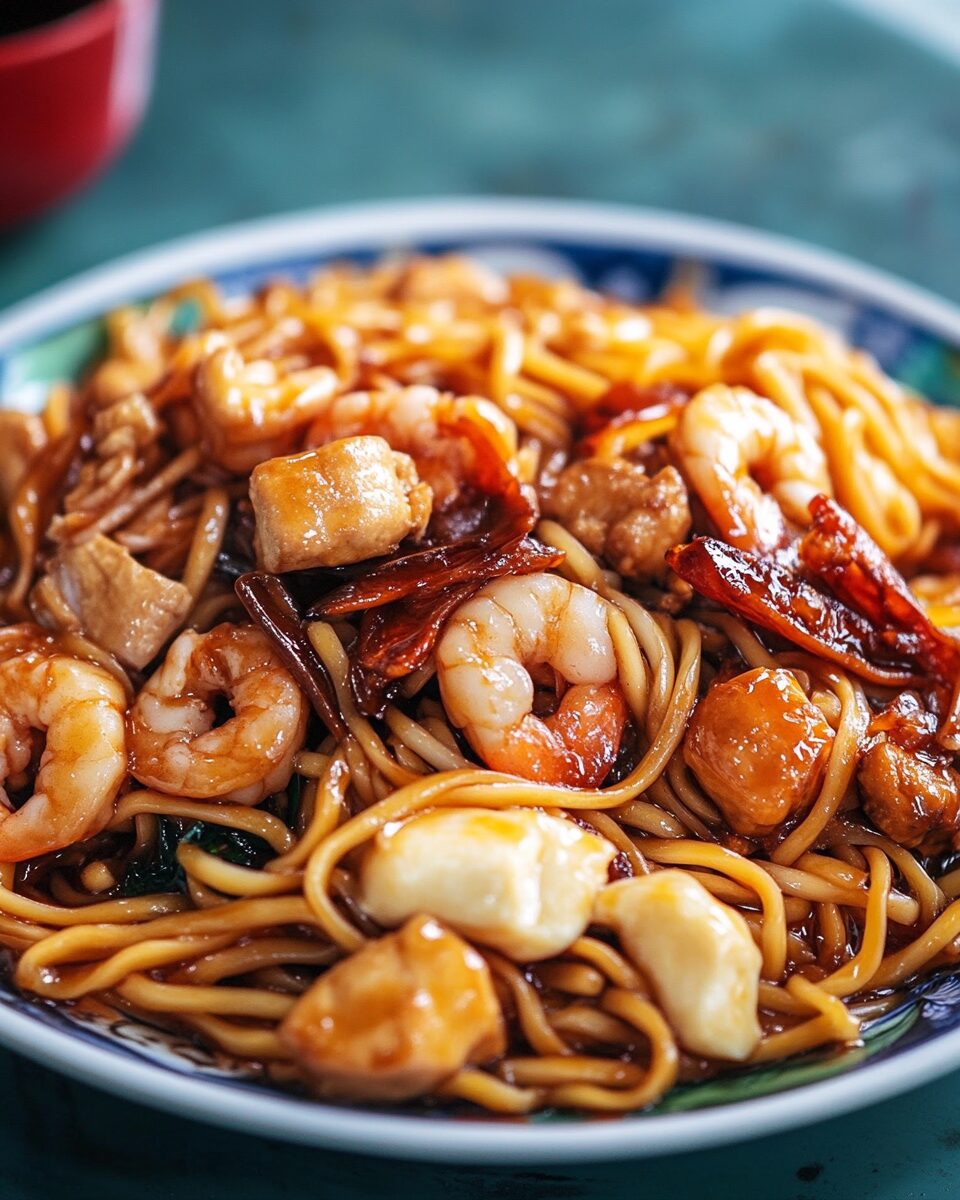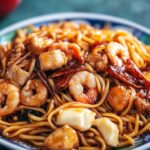Malaysian Hokkien Mee is a beloved street food classic that perfectly balances the savory richness of pork belly with the fresh sweetness of prawns and the satisfying chew of stir-fried noodles. The dark soy sauce and prawn stock create a deep, smoky flavor known as “wok hei” that elevates every bite.
This dish is a celebration of simple, bold flavors combined with fresh ingredients, making it a comforting yet exciting meal to enjoy at home. Whether served for a family dinner or a casual get-together, its aromatic and vibrant character never fails to impress.
Full Recipe:
-
300g fresh yellow noodles
-
150g fresh rice vermicelli (bee hoon)
-
200g prawns, peeled and deveined
-
150g pork belly, sliced thinly
-
4 cloves garlic, minced
-
1 cup cabbage, chopped
-
1 cup choy sum or kai lan (Chinese broccoli), chopped
-
2 tablespoons soy sauce
-
2 tablespoons dark soy sauce
-
1 tablespoon oyster sauce
-
1 tablespoon fish sauce
-
1 teaspoon sugar
-
200ml prawn stock or water
-
2 tablespoons lard or vegetable oil
-
2 fried shallots (for garnish)
-
Lime wedges (to serve)
-
Fresh red chilies or sambal chili (optional)
Directions:
-
Prepare the prawn stock by boiling prawn shells with water for 15 minutes. Strain and set aside.
-
Heat lard or oil in a large wok over medium-high heat. Sauté garlic until fragrant.
-
Add pork belly slices and stir-fry until they start to render fat and become golden.
-
Add prawns and cook until pink and just done. Remove pork and prawns, set aside.
-
In the same wok, add the cabbage and choy sum; stir-fry for 1-2 minutes until slightly softened.
-
Add yellow noodles and rice vermicelli, tossing well.
-
Pour in soy sauce, dark soy sauce, oyster sauce, fish sauce, and sugar; toss to coat noodles evenly.
-
Pour in the prawn stock, stir-fry until the liquid is absorbed and the noodles take on a slightly caramelized, smoky “wok hei” flavor.
-
Return the cooked pork belly and prawns to the wok; toss everything together for a minute to combine.
-
Serve hot, garnished with fried shallots, lime wedges, and sambal or fresh chilies on the side.
Prep Time: 15 minutes | Cooking Time: 20 minutes | Total Time: 35 minutes
Kcal: Approximately 450 kcal per serving | Servings: 3-4 servings
Introduction to Malaysian Hokkien Mee
Malaysian Hokkien Mee is a beloved noodle dish that originates from Kuala Lumpur and the surrounding regions of Malaysia. Known for its rich, smoky aroma and bold flavors, it is one of the signature street foods that showcase Malaysia’s vibrant culinary heritage. Unlike other noodle dishes, this version is distinguished by the use of thick yellow noodles and rice vermicelli stir-fried in a luscious prawn broth infused with dark soy sauce, which gives it a deep, caramelized color and umami-packed flavor.
The Cultural Significance
Hokkien Mee holds a special place in the hearts of many Malaysians and is often regarded as comfort food. The dish was originally created by Chinese immigrants from the Hokkien province in China, who adapted their traditional noodle recipes using local Malaysian ingredients. Over time, it evolved to include a blend of influences, incorporating Southeast Asian flavors and cooking techniques. Today, it’s more than just a meal — it’s a cultural experience representing the fusion of Chinese and Malay culinary traditions in Malaysia.
Flavor Profile and Key Components
What makes Malaysian Hokkien Mee stand out is its deep and smoky flavor, often described by food lovers as “wok hei,” a Cantonese term that means “breath of the wok.” This refers to the unique charred aroma and taste that comes from cooking over a high flame in a wok. The dish balances savory notes from pork belly and soy sauce with the natural sweetness of prawns and the slight bitterness of leafy greens like Chinese broccoli.
The use of dark soy sauce is critical to achieving the dish’s characteristic color and rich taste. Unlike light soy sauce, which is saltier and thinner, dark soy sauce is thicker and sweeter, lending a caramelized glaze to the noodles. The prawn stock made from boiling prawn shells adds a fresh oceanic depth that intensifies the seafood flavor without overpowering the other ingredients.
Variations and Adaptations
While the traditional Malaysian Hokkien Mee is prepared with pork belly and prawns, regional and personal variations abound. Some cooks add squid, fish cake slices, or chicken to vary the texture and protein content. For those avoiding pork, alternatives like chicken or beef can be used, although the pork fat does contribute to the dish’s signature richness.
Vegetarian versions are less common due to the prawn stock base, but creative cooks have adapted it by using mushroom broth and tofu for umami. Additionally, the level of spiciness can be adjusted with the addition of fresh chilies or sambal, catering to those who prefer a mild or fiery kick.
Cooking Techniques and Tips
Achieving the perfect Malaysian Hokkien Mee requires skill and attention to timing. The key is to cook over very high heat so that the noodles absorb the sauces and broth quickly while developing that coveted wok hei flavor. The pork belly should be sliced thinly to render the fat evenly, which coats the noodles with a silky texture.
One challenge for home cooks is replicating the intense heat and rapid stir-frying done by street vendors using commercial woks and gas burners. However, using a heavy-bottomed wok and preheating it thoroughly can help. Stirring constantly and adding the prawn stock gradually will ensure the noodles are moist but not soggy.
Fresh ingredients are essential, especially when it comes to the prawns and greens. Using fresh yellow noodles and rice vermicelli adds the right chewiness and lightness to contrast with the rich sauces.
Pairing and Serving Suggestions
Malaysian Hokkien Mee is usually served hot and garnished with crispy fried shallots and lime wedges, which add crunch and a burst of acidity to balance the richness. It pairs well with a simple side of pickled green chilies or sambal to elevate the flavor with heat.
For a full Malaysian-style meal, it can be accompanied by dishes like asam laksa (tangy fish noodle soup) or satay (grilled meat skewers) to create a varied and satisfying spread. The dish also works beautifully with light, refreshing drinks like iced barley or chrysanthemum tea, which cleanse the palate.
Nutritional Aspects
While Malaysian Hokkien Mee is undeniably delicious, it is also a relatively hearty dish due to the pork belly fat and prawn stock. It provides a good amount of protein from seafood and pork, but the calorie content can be moderate to high depending on portion size and cooking fat used.
Including plenty of vegetables like cabbage and Chinese broccoli boosts the fiber and vitamin content, making the dish more balanced. For those watching calories or fat intake, reducing the amount of lard or substituting with vegetable oil can make it lighter without sacrificing flavor.
Why You Should Try Making Malaysian Hokkien Mee at Home
Making this dish at home allows you to customize it to your taste preferences and dietary needs while enjoying an authentic Malaysian experience. It’s a rewarding cooking project that introduces you to the magic of wok cooking and the bold flavors of Southeast Asia.
Cooking your own Hokkien Mee can also be a fun way to bring family or friends together, whether it’s for a casual dinner or a special occasion. The layers of flavor and textures—from tender pork and juicy prawns to the chewy noodles and crunchy greens—make it a crowd-pleaser everyone will love.
Conclusion
Malaysian Hokkien Mee is more than just a noodle dish; it’s a delicious symbol of Malaysia’s rich cultural tapestry and culinary artistry. Its complex flavors, smoky aroma, and comforting textures have made it a perennial favorite both on the streets and in homes across the country.
Whether you’re an adventurous foodie or simply seeking a satisfying meal packed with flavor, Hokkien Mee offers an unforgettable taste experience. By mastering this recipe, you not only savor an iconic dish but also honor a culinary tradition that has been passed down through generations. Cooking and sharing this dish brings a piece of Malaysia to your table, inviting you to enjoy the harmony of flavors that define its unique food culture.





